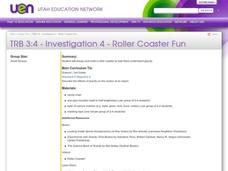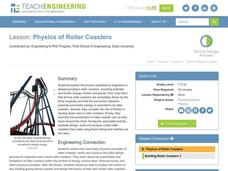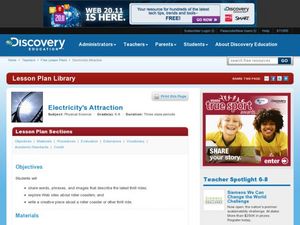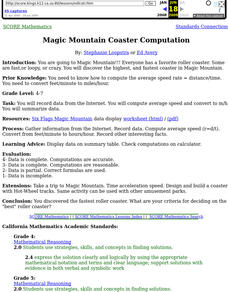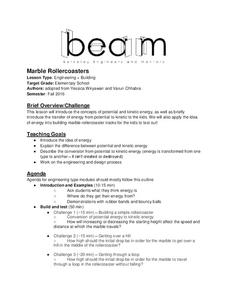Museum of Science
Roller Coaster
Take a marble out for a roll. Using a section of flexible tubing, pupils build a roller coaster that will allow for a marble to act as the car. Learners create a loop, hill, and jump in their coasters by taping the tubing to different...
Curated OER
Physics of Roller Coasters
Students design a roller coaster and demonstrate their knowledge of Potential and Kinetic Energy. They determine the average velocity a given marble travels on their roller coaster and apply their knowledge of various measurement systems...
DiscoverE
Build a Roller Coaster
Let the good times roll as young thrill seekers build a roller coaster on school grounds. Future engineers design and build a roller coaster from flexible tubing. The roller coaster is for a marble, so there will be plenty of room to let...
CK-12 Foundation
Roller Coaster
Roller coasters rely on both kinetic and potential energy, but how much total energy does a roller coaster need? Scholars vary the mass of a coaster and the height of the initial hill. Graphs showing the types of energy and total energy...
MENSA Education & Research Foundation
Roller Coaster Mania!
Raise the energy level of your physical science class with this exciting hands-on activity. Applying their knowledge of kinetic and potential energy and Newton's laws of motion, young engineers use foam tubing and marbles to create...
Curated OER
Roller Coaster Fun
Third graders review the effects of gravity on how objects move. In groups, they design a roller coaster and share it with their classmates. Using materials given to them, they build their roller coaster and let a ball roll on the...
Curated OER
Take a Roller Coaster Ride
Students investigate how roller coasters are built. In this physics activity, students research the laws of physics that affect roller coaster construction. Students create their own roller coaster design.
Curated OER
Building a Roller Coaster
High schoolers describe the law of conservation of energy. They identify the conversion between potential and kinetic energy. They investigate and describe the application of Newton's Laws of Motion.
Curated OER
Roller Coasters
Twisting and turning through the sky, roller coasters are popular attractions at amusement parks around the world, but how exactly do they work? Explore the physics behind these thrilling rides with an engineering design activity....
Teach Engineering
Amusement Park Ride: The Ups and Downs in Design
Groups design the ultimate roller coaster by considering potential and kinetic energy. They test their designs using marbles and then go on to rate each group's design based on aesthetics, loop diameter, and cost.
Anchorage School District
Roller Coaster Project
Emerging engineers work in teams to design pipe insulation roller coasters for marbles that meet specific parameters. They are required to label along the track the areas where kinetic and potential energy are highest and lowest, where...
Curated OER
Physics of Roller Coasters
Students study the physics used to design today's roller coasters. In this engineering lesson students complete several activities including designing their own roller coaster.
Curated OER
Electricity's Attraction
Learners explore the different features of a roller coaster using an interactive website. In this physical science lesson, students explain the role of science to make this thrill ride possible. They develop a creative presentation about...
Curated OER
Ball Bearing Roller Coasters and Teamwork Lab
Students discuss potential and kinetic energy and design roller coasters to study this concept. In this energy lesson, students discuss the potential and kinetic energy of a roller coaster. Students design roller coasters and hypothesize...
Kenan Fellows
Engineering Skills Through Problem Based Learning
Navigate the ups and downs of learning about energy. Future engineers consider how potential and kinetic energy apply to roller coasters. They design a roller coaster of their own and then use computer design software to showcase their...
CK-12 Foundation
Energy Conservation Simulation
Does the amount of a roller coaster's energy change as it goes along the track? Scholars investigate when a roller coaster has potential and kinetic energy. They observe the changes as it goes up the initial hill follows it throughout...
Alabama Learning Exchange
This Is How We Roll!
Students research how roller coasters work. In this physics activity, learners research the history of roller coasters and the safety factors in the design of a roller coaster on the website www.learner.org/exhibits/parkphysics. They...
Curated OER
Rockin Roller Coaster
Students discuss gravitational potential energy, kinetic energy, and the relationship between potential and kinetic energy. They create a working roller coaster from provided materials and criteria then evaluate each roller coaster. They...
Curated OER
Magic Mountain Coaster Computation
Learners use the Internet to do research on the roller coasters at Magic Mountain Amusement Park. They must use mathematical formulas to calculate the highest and fastest coaster at the park.
University of California
Marble Rollercoasters
Don't let your classes coast through school! Engage them in their learning as they build their own roller coasters to study potential and kinetic energy. Young scholars complete several challenges that require them to consider the...
Curated OER
Acceleration
The mechanics of rollercoasters, and the acceleration and velocities reached with the different kinds, are outlined in this presentation. Although short, this would be a great starter for a class working with building rollercoasters or...
Curated OER
Roller Coaster Robot
Students calculate the area under a curve. In this calculus lesson, students use Riemann sums to find and approximate the area under a curve. They use the derivative and differential equations to solve.
Tech Museum of Innovation
Energy at Play
Get the ball rolling and challenge your class to figure out how to make a ball move. The instruction segment is between two STEM activities devoted to doing just that. The first is simple and involves making a ball move from some...
Cornell University
Catapults
Ready, aim, fire! Launch to a new level of understanding as scholars build and test their own catapults. Learners explore lever design and how adjusting the fulcrum changes the outcome.







